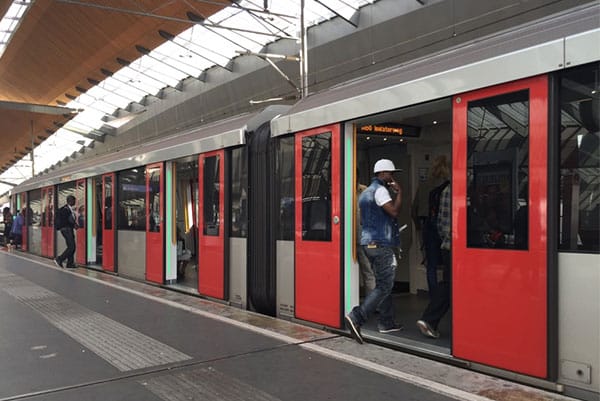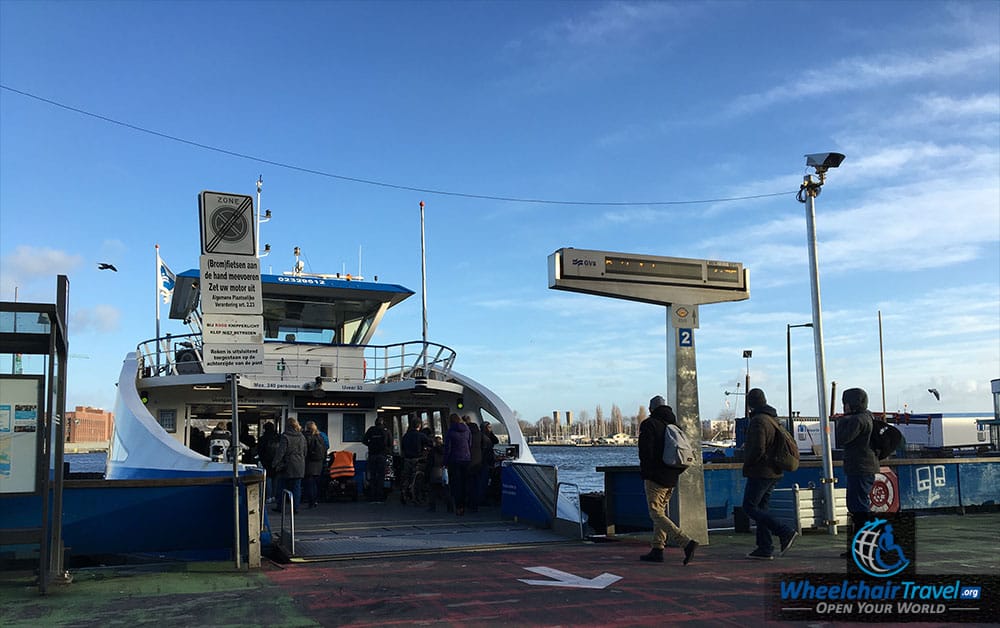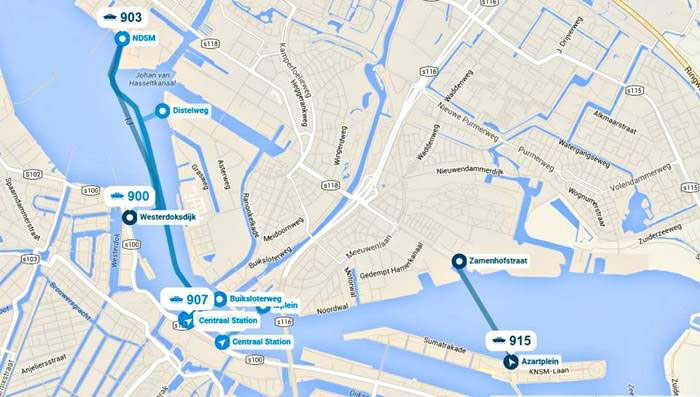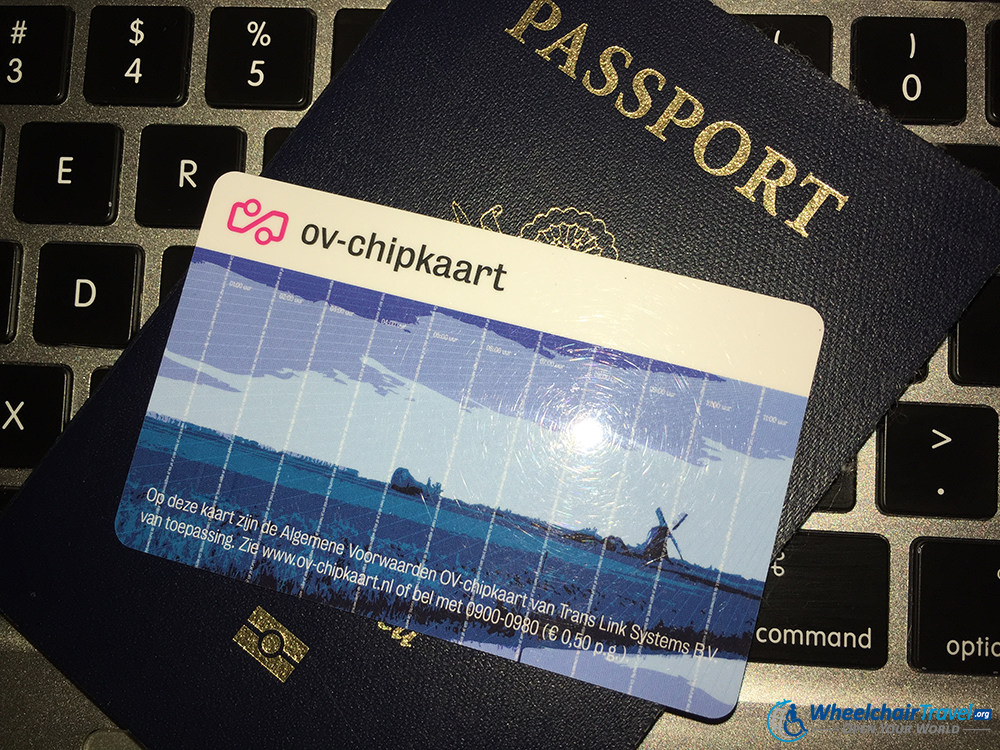
Amsterdam’s public transportation network is partially wheelchair accessible, but there are some important things you need to know. Due to the difficulty of hiring a wheelchair taxi, I rely almost entirely on public transit when visiting the city. On this page, I have outlined the critical accessibility information for each mode of public transportation. I’ve also included some tips that will make using it much less stressful.
Metro Train/Subway

The Amsterdam metro system contains 4 lines numbered 50, 51, 53 and 54. A fifth line, number 52, is currently being constructed, and will open in 2017. The current network contains 33 total stations. All stations are wheelchair accessible. Accessibility features include ramps/elevators to access the station platform and wider fare gates.
The metro system uses four different types of trains, which are assigned at random to different lines. Pictured to the left is the new “M5” model type. This is the most accessible of the four, with a gap of only two inches between train and station platform. Other trains have a gap of 2-4 inches, depending on the station design.
My power wheelchair, the Quantum Q6 Edge, has front caster wheels which measure 3 inches. I have always felt comfortable crossing the gaps, and have never become stuck. Managing these gaps will be much easier for those with manual wheelchairs. My verdict: The Amsterdam metro is very accessible. Wheelchair users should not have trouble using it. Just make sure to pay attention to the route maps and get on the correct train!
On-street Trams
Amsterdam’s city streets also contain the tracks for the tramway trains. The trams are a very popular public transit option, as they are quick and easy to use (for able-bodied commuters). The on-street tram network consists of 15 lines which run throughout the city.
Understanding the reality of wheelchair accessibility on the trams can be difficult. There are many factors at play that determine whether you’ll be able to board the tram with your wheelchair. Here is what the city’s public transit bureau says:
The wheelchair accessible trams of the “older type” have a spot in the lower middle section for a wheelchair. The new Combino trams have a wheelchair ramp and the spot for the wheelchair is located beside the conductor. The spots in the trams are indicated by a sticker.
For both tram and bus, the wheelchair space is also the stroller space. Please remember that a wheelchair always takes precedence over a stroller.
The fleet of tram vehicles consists of two types. The “older type” trams mentioned above have stairs at all doors except the middle one. The middle door has a low floor, but no wheelchair ramp. Newer trams have low floors throughout and a retractable wheelchair ramp at the forwardmost door. The different tram models are rotated throughout the network, so there is no guarantee which type will serve a route on a particular day.
Whether or not you’ll be able to easily board a tram in a wheelchair (or at all, if using a powered chair), depends on the tram stop itself. Many stops have a raised platform that allows level boarding even on the old-style trams. Others have only a partially-raised platform, while some have none at all. The gap between the tram door and raised platforms can be up to 5 inches across. Do determine whether a particular stop has been deemed “wheelchair accessible,” consult the tram timetables/stop information pages at the following links:
Line 1 – Line 2 – Line 3 – Line 4 – Line 5 – Line 7 – Line 9 – Line 10 – Line 12 – Line 13 – Line 14 – Line 16 – Line 17 – Line 24 – Line 26
If you are able to successfully use the trams, be sure to share your experiences in the comments below. I haven’t been able to test and confirm that all of the stops labeled as wheelchair accessible are accurately described correctly.
Dutch National Rail (for service to/from Schiphol Airport)
Two primarily national rail services, the Intercity and Sprinter trains, offer value to tourists. The trains connect the Amsterdam Airport to the city in roughly 15 minutes. They also provide service between the city’s Zuid, Central, and Bijlmer ArenA stations, among others.
Take a look at the video below, which chronicles one of my journeys from Schiphol Airport to the Amsterdam-Zuid train station:
In order to board or alight the train, wheelchair users will need a station employee to set-up the accessible ramp. As is true for all of Europe, the trains keep to a strict schedule. In order to ensure timely service at both ends of your journey, passengers using a wheelchair are required to make a reservation in advance. Reservations can be made by calling the NS Disabled Assistance Office at +31 (0)30-2357822.
If you arrive to the airport and do not have a reservation, consult the information desk. They will set one up for you, but you may have to wait up to one hour. For travel on the Intercity or Sprinter trains to the airport, or between stations inside Amsterdam and the Netherlands, an advance reservation is all but required. It will be difficult to find English-speaking staff at stations outside the airport, and those staff may not be willing to make the calls to get you a reservation.
I have shown up at stations in Amsterdam city twice without a reservation, and convincing someone to help was difficult. After a lot of frustration, I did get the help I needed.
I never make an advance reservation for service from the airport. I never know how long it will take to collect my wheelchair and luggage, so I don’t mind waiting for a reservation to be made for me at the info desk. Once the folks at the airport have set the reservation, I go off for a coffee and pastry while I wait for my train’s scheduled departure.
More information on special assistance on the Dutch National Rail is available at www.ns.nl. Pro tip: Ask your hotel’s concierge to call and make the reservations for you!
City Bus
Amsterdam’s public transit system has 46 city bus routes, many of which operate at night. For the most part, buses do not provide connections to places in central or South Amsterdam. Most of the tourist sites are connected by trams and the metro. Still, buses can provide tourists some value, depending on where you are going. All city buses have a fold-out wheelchair ramp at the rear door, and a space for a wheelchair inside the bus.
Not all bus drivers will know how to operate the ramp. You can do your best to instruct them, but might be better to wait and try your luck with the next driver. The time between buses is 15 minutes to one hour, depending on the route.
To explore the Amsterdam city bus route maps and timetables, visit www.gvb.nl.

Ferries
The city operates ferries on 14 routes across the IJ River, “Amsterdam’s Waterfront.” The ferries are completely free to ride, and are utilized by pedestrians, bicyclists and moped/scooter users. Many of the ferries depart from the Centraal Station, and provide service to multiple points across river.

The Amsterdam ferries are wheelchair accessible. Boarding and alighting is via a ramp that is lowered from the ferry, out onto the dock. Wheelchair users can roll across unassisted. For a complete list of ferry routes and timetables, visit www.gvb.nl.
Cost and How to Pay

The OV-chipkaart (Chip Card) is an easy to use, reloadable public transport card. It can be purchased a ticket vending machines, and is valid for use on all of Amsterdam’s public transport services, as well as on the Dutch National Rail trains throughout the Netherlands.
Pick an OV-chipkaart up at the airport, load it with funds, and tap your way on and off the public transportation system. When you tap onto a public transit service, a hold of €4,00 will be placed against the balance of your card. Your fare will be calculated and deducted when you “tap out” or “tap off” of a bus, tram, metro train, or national train.
The current fare structure is based on distance traveled, plus a the base fare of €0,88. Each kilometer traveled is charged at a cost of €0,15. A trip of two kilometer would be €0,88, plus €0,15 (first km), plus €0,15 (second km), for a total of €1,18. Public transportation is a great deal in Amsterdam!
More information on purchasing and using the OV-chipkaart is available on the GVB website.



